Unit 8 The food we eat 教案
文档属性
| 名称 | Unit 8 The food we eat 教案 | 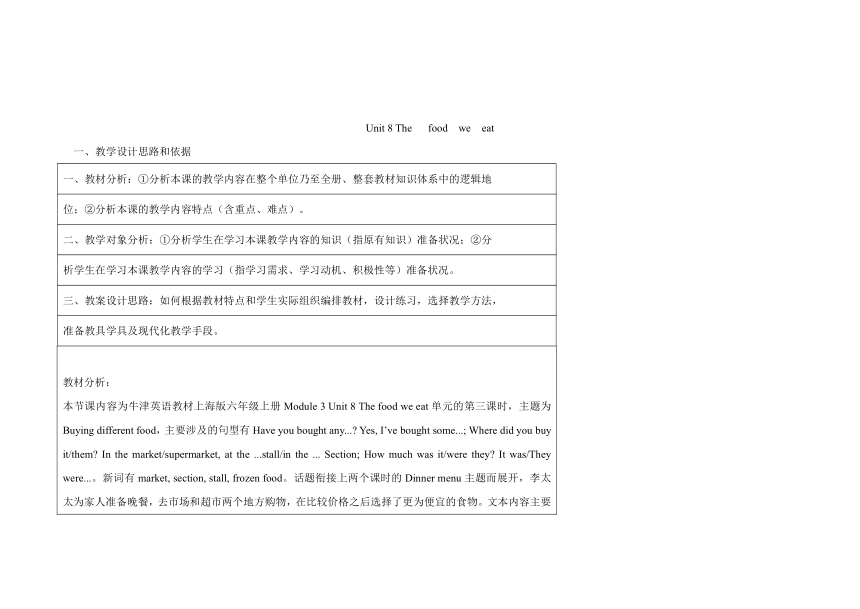 | |
| 格式 | zip | ||
| 文件大小 | 213.7KB | ||
| 资源类型 | 教案 | ||
| 版本资源 | 牛津上海版(试用本) | ||
| 科目 | 英语 | ||
| 更新时间 | 2017-09-02 15:51:36 | ||
图片预览

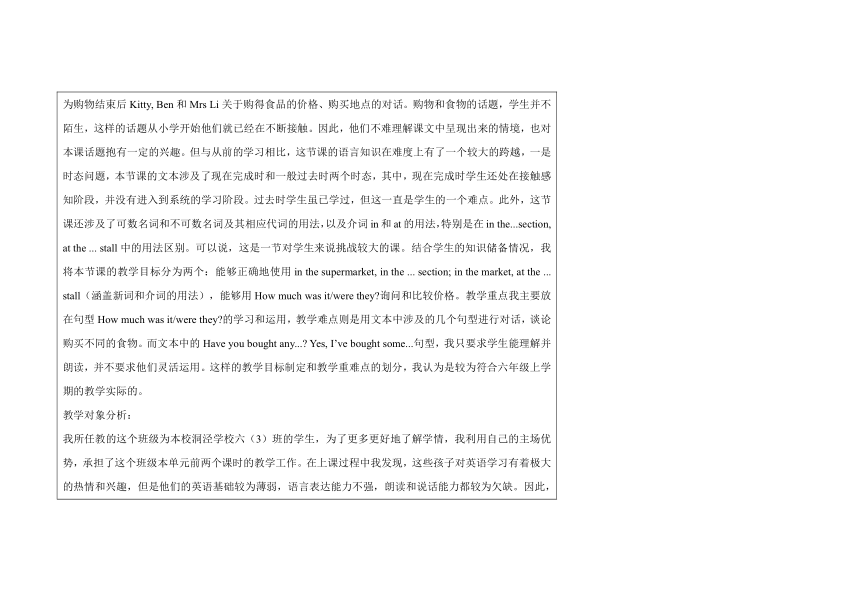
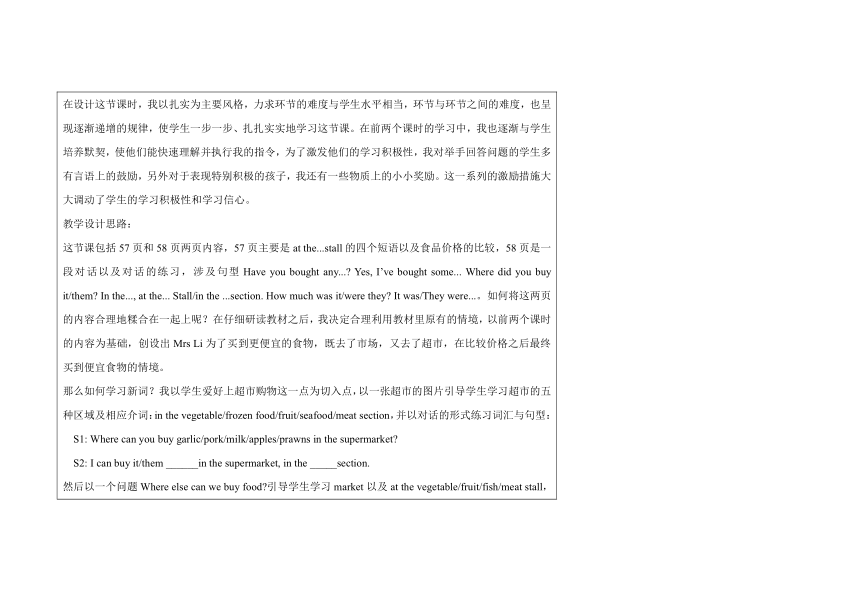
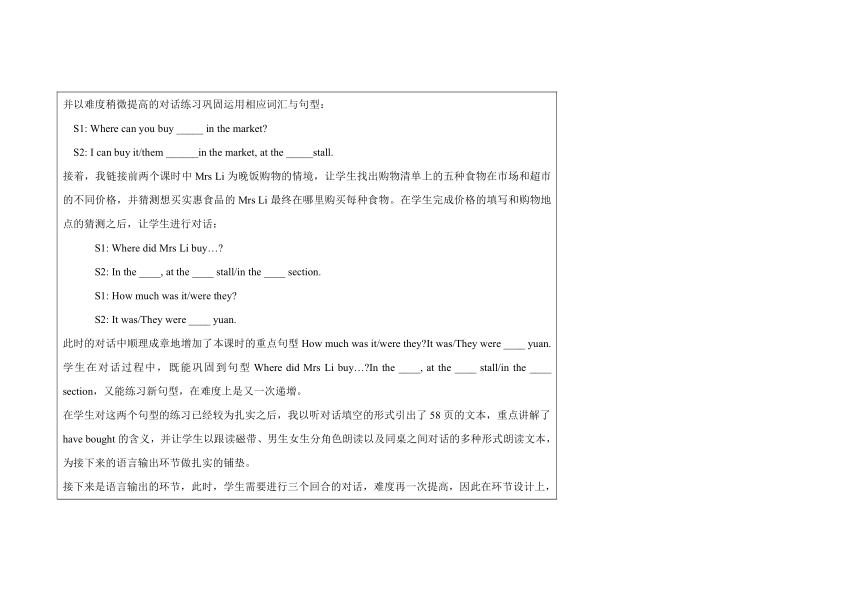
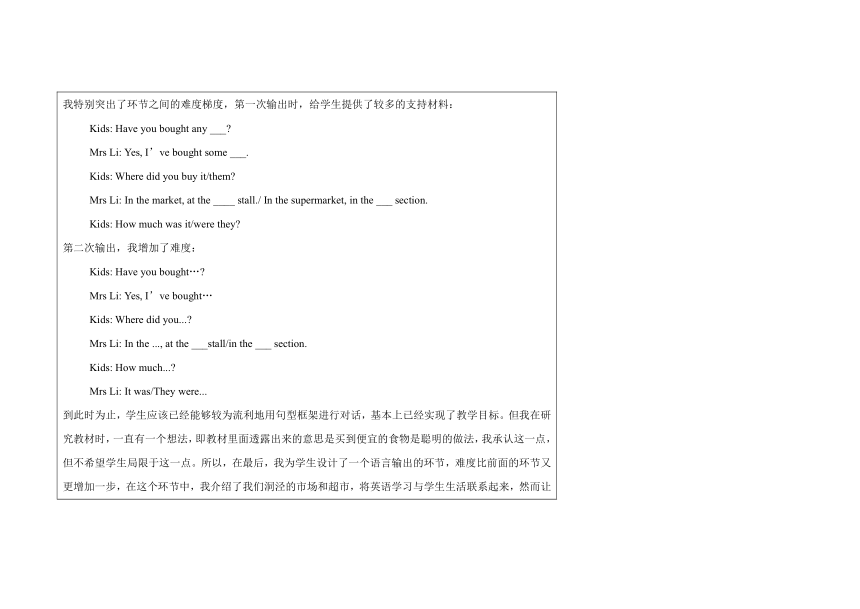
文档简介
Unit 8 The food we eat
一、教学设计思路和依据
一、教材分析:①分析本课的教学内容在整个单位乃至全册、整套教材知识体系中的逻辑地
位;②分析本课的教学内容特点(含重点、难点)。
二、教学对象分析:①分析学生在学习本课教学内容的知识(指原有知识)准备状况;②分
析学生在学习本课教学内容的学习(指学习需求、学习动机、积极性等)准备状况。
三、教案设计思路:如何根据教材特点和学生实际组织编排教材,设计练习,选择教学方法,
准备教具学具及现代化教学手段。
教材分析:
本节课内容为牛津英语教材上海版六年级上册Module 3 Unit 8 The food we eat单元的第三课时,主题为Buying different food,主要涉及的句型有Have you bought any...? Yes, I’ve bought some...; Where did you buy it/them? In the market/supermarket, at the ...stall/in the ... Section; How much was it/were they? It was/They were...。新词有market, section, stall, frozen food。话题衔接上两个课时的Dinner menu主题而展开,李太太为家人准备晚餐,去市场和超市两个地方购物,在比较价格之后选择了更为便宜的食物。文本内容主要为购物结束后Kitty, Ben和Mrs Li关于购得食品的价格、购买地点的对话。购物和食物的话题,学生并不陌生,这样的话题从小学开始他们就已经在不断接触。因此,他们不难理解课文中呈现出来的情境,也对本课话题抱有一定的兴趣。但与从前的学习相比,这节课的语言知识在难度上有了一个较大的跨越,一是时态问题,本节课的文本涉及了现在完成时和一般过去时两个时态,其中,现在完成时学生还处在接触感知阶段,并没有进入到系统的学习阶段。过去时学生虽已学过,但这一直是学生的一个难点。此外,这节课还涉及了可数名词和不可数名词及其相应代词的用法,以及介词in和at的用法,特别是在in the...section, at the ... stall中的用法区别。可以说,这是一节对学生来说挑战较大的课。结合学生的知识储备情况,我将本节课的教学目标分为两个:能够正确地使用in the supermarket, in the ... section; in the market, at the ... stall(涵盖新词和介词的用法),能够用How much was it/were they?询问和比较价格。教学重点我主要放在句型How much was it/were they?的学习和运用,教学难点则是用文本中涉及的几个句型进行对话,谈论购买不同的食物。而文本中的Have you bought any...? Yes, I’ve bought some...句型,我只要求学生能理解并朗读,并不要求他们灵活运用。这样的教学目标制定和教学重难点的划分,我认为是较为符合六年级上学期的教学实际的。
教学对象分析:
我所任教的这个班级为本校洞泾学校六(3)班的学生,为了更多更好地了解学情,我利用自己的主场优势,承担了这个班级本单元前两个课时的教学工作。在上课过程中我发现,这些孩子对英语学习有着极大的热情和兴趣,但是他们的英语基础较为薄弱,语言表达能力不强,朗读和说话能力都较为欠缺。因此,在设计这节课时,我以扎实为主要风格,力求环节的难度与学生水平相当,环节与环节之间的难度,也呈现逐渐递增的规律,使学生一步一步、扎扎实实地学习这节课。在前两个课时的学习中,我也逐渐与学生培养默契,使他们能快速理解并执行我的指令,为了激发他们的学习积极性,我对举手回答问题的学生多有言语上的鼓励,另外对于表现特别积极的孩子,我还有一些物质上的小小奖励。这一系列的激励措施大大调动了学生的学习积极性和学习信心。
教学设计思路:
这节课包括57页和58页两页内容,57页主要是at the...stall的四个短语以及食品价格的比较,58页是一段对话以及对话的练习,涉及句型Have you bought any...? Yes, I’ve bought some... Where did you buy it/them? In the..., at the... Stall/in the ...section. How much was it/were they? It was/They were...。如何将这两页的内容合理地糅合在一起上呢?在仔细研读教材之后,我决定合理利用教材里原有的情境,以前两个课时的内容为基础,创设出Mrs Li为了买到更便宜的食物,既去了市场,又去了超市,在比较价格之后最终买到便宜食物的情境。
那么如何学习新词?我以学生爱好上超市购物这一点为切入点,以一张超市的图片引导学生学习超市的五种区域及相应介词:in the vegetable/frozen food/fruit/seafood/meat section,并以对话的形式练习词汇与句型:
S1: Where can you buy garlic/pork/milk/apples/prawns in the supermarket?
S2: I can buy it/them ______in the supermarket, in the _____section.
然后以一个问题Where else can we buy food?引导学生学习market以及at the vegetable/fruit/fish/meat stall,并以难度稍微提高的对话练习巩固运用相应词汇与句型:
S1: Where can you buy _____ in the market?
S2: I can buy it/them ______in the market, at the _____stall.
接着,我链接前两个课时中Mrs Li为晚饭购物的情境,让学生找出购物清单上的五种食物在市场和超市的不同价格,并猜测想买实惠食品的Mrs Li最终在哪里购买每种食物。在学生完成价格的填写和购物地点的猜测之后,让学生进行对话:
S1: Where did Mrs Li buy…?
S2: In the ____, at the ____ stall/in the ____ section.
S1: How much was it/were they?
S2: It was/They were ____ yuan.
此时的对话中顺理成章地增加了本课时的重点句型How much was it/were they?It was/They were ____ yuan.学生在对话过程中,既能巩固到句型Where did Mrs Li buy…?In the ____, at the ____ stall/in the ____ section,又能练习新句型,在难度上是又一次递增。
在学生对这两个句型的练习已经较为扎实之后,我以听对话填空的形式引出了58页的文本,重点讲解了have bought的含义,并让学生以跟读磁带、男生女生分角色朗读以及同桌之间对话的多种形式朗读文本,为接下来的语言输出环节做扎实的铺垫。
接下来是语言输出的环节,此时,学生需要进行三个回合的对话,难度再一次提高,因此在环节设计上,我特别突出了环节之间的难度梯度,第一次输出时,给学生提供了较多的支持材料:
Kids: Have you bought any ___?
Mrs Li: Yes, I’ve bought some ___.
Kids: Where did you buy it/them?
Mrs Li: In the market, at the ____ stall./ In the supermarket, in the ___ section.
Kids: How much was it/were they?
第二次输出,我增加了难度:
Kids: Have you bought…?
Mrs Li: Yes, I’ve bought…
Kids: Where did you...?
Mrs Li: In the ..., at the ___stall/in the ___ section.
Kids: How much...?
Mrs Li: It was/They were...
到此时为止,学生应该已经能够较为流利地用句型框架进行对话,基本上已经实现了教学目标。但我在研究教材时,一直有一个想法,即教材里面透露出来的意思是买到便宜的食物是聪明的做法,我承认这一点,但不希望学生局限于这一点。所以,在最后,我为学生设计了一个语言输出的环节,难度比前面的环节又更增加一步,在这个环节中,我介绍了我们洞泾的市场和超市,将英语学习与学生生活联系起来,然而让学生看我前一天的购物单,以及购物单上的食品在洞泾市场和洞泾吉买盛超市的价位,让他们猜一猜这些食物是在哪里买到的,以角色扮演的形式进行对话:
Miss Zhang: Have you bought…?
Her husband: Yes, I’ve bought…
Miss Zhang: Where...?
Her husband: In the ..., at the ___stall/in the ___ section.
Miss Zhang: How much...?
Her husband: ...
最后,我将每种食物在哪里购得的答案揭晓,选择有些食物是因为更便宜,选择有些食物是因为更新鲜,还有一些是因为更好吃(如超市的猪肉比市场的好吃)。这样,让学生在进行购物选择时可以考虑更多的因素,做一个更明智的购物者。
二、教案
课 题
M3U8 Buying different food 第 3 课时
教 学
目 标
To understand and use “in the market, at the ... stall” and “in the supermarket, in the ... section” correctly by picture talking and making dialogues
To use “How much was it/were they? ” to compare and find out prices
教 学
重 点
To use “How much was it/were they? ” to compare and find out prices
教 学
难 点
To talk about buying different food using the sentence patterns of this lesson
现代媒体准 备
(含教具、学具)
PPT课件
课
前
准
备
︵
含
预
习
布
置
︶
实地拍摄照片若干
要求学生复习P55,56页的课文和单词
教案续1
板书设计:
M3U8 Buying different food
in the supermarket, in the vegetable/seafood/frozen food/fruit/meat section
in the market, at the vegetable/fish/fruit/meat stall
How much was it/were they?
It was/They were...
练习设计(需充分考虑优等生与后进生的训练)
Ask and answer
A. S1: Where can you buy garlic/pork/milk/apples/prawns in the supermarket?
S2: I can buy it/them ______in the supermarket, in the _____section.
B. S1: Where can you buy _____ in the market?
S2: I can buy it/them ______in the market, at the _____stall.
Make a dialogue according to the table
S1: Where did Mrs Li buy…?
S2: In the ____, at the ____ stall/in the ____ section.
S1: How much was it/were they?
S2: It was/They were ____ yuan.
3. Make Mrs Li’s dialogues with her children
A. Kids: Have you bought any ___?
Mrs Li: Yes, I’ve bought some ___.
Kids: Where did you buy it/them?
Mrs Li: In the market, at the ____ stall./ In the supermarket, in the ___ section.
Kids: How much was it/were they?
Mrs Li: It was/They were ___ yuan.
B. Kids: Have you bought…?
Mrs Li: Yes, I’ve bought…
Kids: Where did you...?
Mrs Li: In the ..., at the ___stall/in the ___ section.
Kids: How much...?
Mrs Li: It was/They were...
教案续2
教学过程:
Step 1: Lead the topic by picture talking
T: What is this place in the picture?
Ss: It’s a supermarket.
T: Do you like going shopping in the supermarket?
Ss: Yes!
T: What can you buy in the supermarket?
Ss: I can buy...
Step 2:. Learn some phrases by picture talking and making dialogues
A. in the vegetable/frozen food/meat/seafood/fruit section
S1: Where can you buy garlic/pork/milk/apples/prawns in the supermarket?
S2: I can buy it/them ______in the supermarket, in the _____section.
B. at the vegetable/fish/meat/fruit stall
S1: Where can you buy _____ in the market?
S2: I can buy it/them ______in the market, at the _____stall.
Step3: Find out the different prices of the food Mrs Li wanted to buy in the market and the supermarket and make dialogues accordingly
A. Compare and find out the different prices of the food in the market and in the supermarket
B. Make a dialogue
S1: Where did Mrs Li buy…?
S2: In the ____, at the ____ stall/in the ____ section.
S1: How much was it/were they?
S2: It was/They were ____ yuan.
Step 4: Listen and complete Mrs Li’s dialogue with Ben and read the dialogue in different ways
Ben: Mum, have you bought any garlic?
Mrs Li: Yes, I’ve bought some garlic.
Ben: _____ did you buy it?
Mrs Li: _____ the market, _____ the vegetable stall.
Ben: _____ was it?
Mrs Li: It was five yuan.
Step 5:Make Mrs Li’s dialogues with her children with the information given
A.
Kids: Have you bought any ___?
Mrs Li: Yes, I’ve bought some ___.
Kids: Where did you buy it/them?
Mrs Li: In the market, at the ____ stall./ In the supermarket, in the ___ section.
Kids: How much was it/were they?
Mrs Li: It was/They were ___ yuan.
B.
Kids: Have you bought…?
Mrs Li: Yes, I’ve bought…
Kids: Where did you...?
Mrs Li: In the ..., at the ___stall/in the ___ section.
Kids: How much...?
Mrs Li: It was/They were...
Step 6: Role-play
Miss Zhang: Have you bought…?
Her husband: Yes, I’ve bought…
Miss Zhang: Where...?
Her husband: In the ..., at the ___stall/in the ___ section.
Miss Zhang: How much...?
Her husband: ...
Homework:
1. Recite the text on page 58
2. Workbook, page 50 and page 51
3. Go shopping for today's dinner and make a dialogue with your clasmates tomorrow
S1: What did you have for dinner yesterday?
S2: I had...
S1: Have you bought...?
S2: Yes, I’ve bought...
S1: Where...?
S2: In the ..., at the ___stall/in the ___ section.
S1: How much ...?
S2: ...
三、教后反思(对教案与课堂教学的自我评价)
这节课的内容包括57页和58页两页的内容,57页讲比较价格,58页则是用几个句型进行对话,询问是否已经购买某种食品、购买的价格以及地点,教材对这两页内容的课型定为听说课。我在设计这堂课的过程中,对两页的内容做了较合理的安排,既体现了比较价格这一主题,对话环节的学习也很充分。此外,为了了解学情,我也做了大量的准备工作,提前和他们接触互动,了解他们的情况,因此,这堂课的整体难度与风格可以说是比较适合学生学情的。例如,我发现很多孩子存在发音不标准和难以掌握新词发音的问题,这也是农村学校的普遍情况。因此,在教授新词时,我以扎实为主,让学生大量朗读和跟读,为避免重复朗读令学生感到枯燥,我设计了多种朗读形式,开小火车读、男女生分读、全班齐读、分角色读等等,让学生在丰富多样的朗读环节中掌握新词发音。此外,考虑到学生基础比较薄弱,在学习句型和文本时,我特别关注每个环节的难易程度是否适中以及环节之间的难度梯度,力求每个环节都能让大部分学生参与进来,在一个个难度逐渐递增的环节中,学生能够扎实地、自然地掌握重点,突破难点。我希望达到的效果,是学生在参与每一个学习任务时,都不觉得太难,而又最终能够流利地运用今天所学的语言。在最后的语言输出环节,其实留给学生的语言支持已经非常少,但由于前面多个环节的层层铺垫,学生到了语言输出的环节,就能很自然、很自如地运用这堂课的词汇与句型进行语言输出,他们在不知不觉中,已经实现了这节课的学习目标。
除了关注学情和教学设计,我也十分注重教师的课堂用语在引导、过渡、激励和纠正方面的功能。在上课之前,我将环节过渡的语言一一写下来,仔细推敲,因此这节课的每个环节的过渡是很自然的,由于准备充分,平时自己在这方面的操练也比较多,所以即使遇到了突发情况,也能很快地反应过来。在激励用语方面,我平时就比较注重这类用语的积累,我希望我能给每个学生恰如其分的表扬和欣赏,使用的称赞语言不让他们觉得千篇一律,我也更看重我表扬时的态度,真诚的赞美和表扬学生是能感觉到的,我使用眼神、语气、手势等多种方式,让学生真实地感受到我的称赞。学生在英语课堂上常常会犯语言错误,怎样纠正他们呢?我也采取了多种方式,如重复学生错误的语言,让学生自己发现,或者给学生一点提示,让他再考虑一会,在学生实在无法发现自己错误的情况下,温和地纠正或请其他学生纠正,一旦学生纠正了错误,就给予表扬和赞赏。我不放过课堂上的每一个细节,我认为学生可以在每一个细节里学到东西,所以我也要看重每一个细节,不放过任何一个教育或教学的契机。
其次,我努力挖掘教材中的情感价值。这节课的一个重点是比较价格,主人公Mrs Li在比较价格之后选择了更加便宜的食品,这是一个聪明的购物者的做法,但我们在购物时,不仅要考虑价格因素,还要考虑食材的质量好坏与新鲜程度。因此,我也将这种意识渗透在教学环节之中,在最后的角色扮演环节,让学生猜我们家昨晚的食材是在哪里买到的,学生果然按照课文的思路猜价格更便宜的地方。我揭晓了谜底,并作出了解释,在质量差不多的情况下,我优先考虑价格,而口感或质量差异较大的食材,我则优先考虑口感和质量。我希望学生通过上这一节课,不仅学习到如何使用相关的语言,更能学习到一些生活常识,正如英语新课程标准所说的,英语这门学科不仅具有工具性,也具有人文性。
总得来说,我觉得自己的这节课达到了我预期的目标,学生实现了教学目标,我对自己在教学设计、课堂表现、教师教态、教学语言、时间把控等方面的表现也比较满意。但是,在准备和上这节课的整个过程当中,我一直在反思,我发现自己还存在许多不足。例如,我最开始的思路是让学生在前一天和爸爸妈妈去买菜,记下食物的价格和购买地点,然后以此为话题展开这节课的学习。但我们教研组的老师指出,引出话题应当快速、直接,太过迂回难以操作,所以我后面立马做了修改。此外,在上课时,我意识到这节课作为一节听说课,我比较侧重说,而忽视了听,学生在课上听的太少了,这可以说是这节课的一个缺憾。如果下次再上这节课,我会增加一个让学生听听力然后填价格和购买地点的环节,让学生听的能力得到训练和提高。
同课章节目录
- Module 1 Family and friends
- Unit 1 Family and relatives
- Unit 2 I have a good friend
- Unit 3 Spending a day out togethe
- Module 2 Places and activities
- Unit 4 What would you like to be?
- Unit 5 Open Day
- Unit 6 Going to school
- Unit 7 Rules round us
- Module 3 Food and drink
- Unit 8 The food we eat
- Unit 9 Picnics are fun
- Unit 10 Healthy eating
- Unit 11 Let's make a pizza
